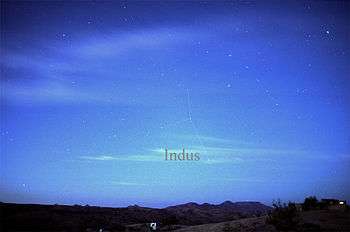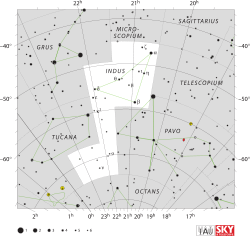Indus (constellation)
| Constellation | |
|
| |
| Abbreviation | Ind |
|---|---|
| Genitive | Indi |
| Pronunciation |
/ˈɪndəs/, genitive /ˈɪndaɪ/ |
| Symbolism | the Indian |
| Right ascension | 21 |
| Declination | −55 |
| Family | Bayer |
| Quadrant | SQ4 |
| Area | 294 sq. deg. (49th) |
| Main stars | 3 |
| Bayer/Flamsteed stars | 16 |
| Stars with planets | 3 |
| Stars brighter than 3.00m | 0 |
| Stars within 10.00 pc (32.62 ly) | 1 |
| Brightest star | The Persian (α Ind) (3.11m) |
| Nearest star |
Epsilon Indi (11.83 ly, 3.62 pc) |
| Messier objects | none |
| Meteor showers | none[1] |
| Bordering constellations |
Microscopium Sagittarius (corner) Telescopium Pavo Octans Tucana Grus |
|
Visible at latitudes between +15° and −90°. Best visible at 21:00 (9 p.m.) during the month of September. | |
Indus is a constellation in the southern sky created in the late sixteenth century.
Features

Indus does not contain any bright stars. Alpha Indi is the brightest star in Indus. It is an orange giant of magnitude 3.1, 101 light-years from Earth. Beta Indi is an orange giant of magnitude 3.7, 600 light-years from Earth. Delta Indi is a white star of magnitude 4.4, 185 light-years from Earth.
Epsilon Indi is one of the closest stars to Earth, approximately 11.8 light years away. It is an orange dwarf of magnitude 4.7, meaning that the yellow dwarf Sun is slightly hotter and larger.[2] The system has been discovered to contain a pair of binary brown dwarfs, and has long been a prime candidate in SETI studies.[3][4]
Indus is home to one bright binary star. Theta Indi is a binary star divisible in small amateur telescopes, 97 light-years from Earth. Its primary is a white star of magnitude 4.5 and its secondary is a white star of magnitude 7.0.[2]
T Indi is the only bright variable star in Indus. It is a semi-regular, deeply coloured red giant with a period of 11 months, 1900 light-years from Earth. Its minimum magnitude is 7 and its maximum magnitude is 5.[2]
Galaxies include NGC 7090 and NGC 7049.
All Sky Automated Survey for SuperNovae (ASAS-SN) in 2015 detected a superluminous supernova, named ASASSN-15lh (also designated SN 2015L[5]). Based on the study conducted by Subo Dong and team from the Kavli Institute for Astronomy and Astrophysics (KIAA) at Peking University, ASAS-SN-15lh was two times more luminous than any supernova previously discovered, and at peak was almost 50 times more luminous than the entire Milky Way galaxy[6]
History

The constellation was one of twelve created by Petrus Plancius from the observations of Pieter Dirkszoon Keyser and Frederick de Houtman[2] and it first appeared on a 35-cm diameter celestial globe published in 1597 (or 1598) in Amsterdam by Plancius with Jodocus Hondius. The first depiction of this constellation in a celestial atlas was in Johann Bayer's Uranometria of 1603.[7][8] Plancius portrayed the figure as a nude male with arrows in both hands but no bow.[9]
References
- ↑ Anonymous (February 3, 2007). "Meteor Showers". American Meteor Society. Retrieved 2008-05-07.
- 1 2 3 4 Ridpath & Tirion 2001, pp. 162-163.
- ↑ Burnham, Robert; Luft, Herbert A. (1978). Burnham's Celestial Handbook: An Observer's Guide to the Universe Beyond the Solar System. Courier Dover Publications. ISBN 0-486-23568-8.
- ↑ Lawton, A. T. (1975). "CETI from Copernicus". Spaceflight. 17: 328–330. Bibcode:1975SpFl...17..328L.
- ↑ Central Bureau for Astronomical Telegrams CBET 4120
- ↑ Carnegie Institution for Science (January 14, 2016). "Most-luminous supernova ever discovered". phys.org. Retrieved January 15, 2016.
- ↑ Bakich, Michael E. (1995). The Cambridge Guide to the Constellations. Cambridge University Press. ISBN 0-521-44921-9.
- ↑ Sawyer Hogg, Helen (1951). "Out of Old Books (Pieter Dircksz Keijser, Delineator of the Southern Constellations)". Journal of the Royal Astronomical Society of Canada. 45: 215. Bibcode:1951JRASC..45..215S.
- ↑ Allen, Richard Hinckley (1963). Star Names, Their Lore and Meaning. New York: Dover Publications. ISBN 0-486-21079-0.
Sources
- Ridpath, Ian; Tirion, Wil (2001), Stars and Planets Guide, Princeton University Press, ISBN 0-691-08913-2
- Ian Ridpath and Wil Tirion (2007). Stars and Planets Guide, Collins, London. ISBN 978-0-00-725120-9. Princeton University Press, Princeton. ISBN 978-0-691-13556-4.
External links
![]() Media related to Indus (constellation) at Wikimedia Commons
Media related to Indus (constellation) at Wikimedia Commons
- Starry Night Photography: Indus Constellation
- Star Tales–Indus
- Indus Constellation at Constellation Guide
Coordinates: ![]() 21h 00m 00s, −55° 00′ 00″
21h 00m 00s, −55° 00′ 00″
